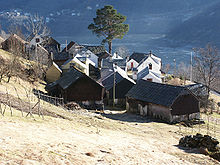
A cluster farm[1][2][3] (Norwegian: klyngetun)[4] is a traditional western Norwegian farm settlement with multiple individual farms and with the houses of the various farms located close together, more or less irregularly in relation to each other, so that it is difficult to see any regular pattern.
Typical examples of cluster farms include Havrå on the island of Osterøy,[3] Agatunet in the Hardanger district,[5] Henjum in Hermansverk,[6] Tyssedalen in the municipality of Fjaler,[7] Osmundnes in the municipality of Gloppen,[8] Sjønstå in the municipality of Fauske,[9] and remaining parts of Larsbakken.[10]
Cluster farms originated through repeated division of farms. The division was to be made fairly, and so every single field plot was therefore divided. The plots of land therefore became increasingly smaller, and each user received an increasingly complex property to deal with.
References[edit]
- ^ Bugge, Gunnar, & Christian Norberg-Schulz. 1969. Stav og laft i Norge. Oslo: Byggekunst, p. 11.
- ^ Bye, Mette. 2010. Histories of Architectural Conservation, doctoral dissertation. Trondheim: Norwegian University of Science and Technology, p. 257.
- ^ a b Fournier, Raphaël. Norwegian farm life and architecture.
- ^ Språkrådet. Nynorskordboka: klyngetun.
- ^ Helle, Knut. 2006. Vestlandets historie: Samfunn, volume 2. Bergen: Vigmostad & Bjørke, p. 67.
- ^ Halsnes, Marit Henjum. Velkommen til Henjatunet.
- ^ Kommuneplanen sin samfunnsdel 2014–2025. Fjaler: Fjaler kommune, p. 26.
- ^ Osmundes 34/ 2-5 og 7- i Gloppen kommune - vedtak om fredning med heimel i lov om kulturminner § § 15 og 19 jf. § 22. 2014. Oslo: Riksantikvaren: Direktorat for kulturminneforvaltning.
- ^ Ingvaldsen, Jan-Olav. 2013. Har brukt seks millioner på å berge gården fra 1600-tallet. Nordlys (October 25).
- ^ Fjaler Kommune, Kulturminner. Florø: Fjaler Kommune.
Further reading[edit]
- Visted, Kristofer, & Hilmar Stigum. 1971. Vår gamle bondekultur. Oslo: Cappelen, ISBN 82-02-07709-5.
- Vreim, Halvor. 1938. Trekk fra byggeskikkens geografi i Norge. Årsberetning 1936–37. Oslo: Foreningen til norske fortidsminnesmerkers bevaring.
- Lars Roede. 2014. Bygningsarven 1814. In: Jørn Holme (ed.), De kom fra alle kanter – Eidsvollsmennene og deres hus, pp. 25–51. Oslo: Cappelen Damm 2014, p. 43. ISBN 978-82-02-44564-5.